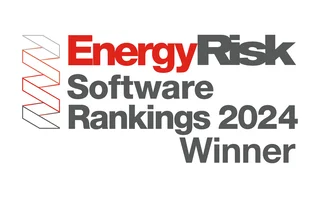
Vendor’s wide services across planning, building and operating assets underlie strong rankings performance


Hitachi Energy’s wide portfolio spans support for planning, building and operating assets. Energy Risk speaks to the vendor about how this has contributed to its strong Software Rankings performance in 2024
Sporadic market events such as supply disruption, and longer-term trends such as decarbonisation, have given energy companies a lot to think about when it comes to risk management in recent years. The ability to forecast a variety of scenarios and anticipate the impact of different types of events has been crucial in helping companies remain agile in all kinds of market conditions.

For technology providers, continued investment is key to supporting clients in this environment. They need access to a wide range of tools for planning, operations, trading and analytics. According to Michael Hinton, the company’s global head for energy portfolio management, this idea has been central to Hitachi Energy’s ability to support its clients over the past year.
“We’ve invested in our people and our solutions,” he says. “Given the size of our organisation, we also have a unique partner network.”
Hitachi Energy works closely with several ‘hyper scalers’, or large cloud-service providers, including Microsoft, Amazon Web Services and Google. “Our relationships with these companies give us more insight into new technologies we can deploy within our solutions,” Hinton continues. “And so we invest in parallel with these partners to provide the solutions customers need, along with the security and the reliability they want for their operations.”
This approach saw Hitachi Energy voted the top provider by Energy Risk readers in a wide range of categories in the Energy Risk Software Rankings 2024, including front-office and middle-office software, and cloud-based system. Hitachi Energy came first in categories including gas, power, carbon emissions and green certificates, and was ranked number one for attributes such as useability, understanding client needs and customer support. We spoke to Hinton to find out how the provider has been developing its offering in recent years.
How does your offering stand out compared to the competition?
Michael Hinton: What’s unique about Hitachi Energy is that we have a very broad set of solutions, encompassing everything a company might need, from planning assets all the way through to building them and then operating them. These tools allow customers to understand, ahead of time, what they should build and how to augment their assets, or maybe what they should acquire in the future. It allows organisations to make longer-term decisions and understand potential financial performance.
Once new assets are in play, companies need long-term optimisation capabilities to understand positions and performance. They need to make decisions around managing and negotiating power purchase agreements, for example, or how to hedge assets. All of this can be formulated before an asset is even operational.
Companies need another set of tools to optimise and dispatch those assets once they’re up and running, as well as tools that can communicate directly to the market to create bids and offers. They need tools for analytics, and Hitachi Energy provides large datasets from around the globe on everything from pricing and weather to geospatial information.
And, on the environmental side of the market, customers need to be able to understand their carbon footprints and manage offsetting programmes. Hitachi Energy provides this as part of its very large platform – this breadth truly differentiates us in the marketplace. It allows us to provide more value to the customer than just the ability to create a system of record for transactions and then manage and control those functions.
How does your offering support clients in creating risk management strategies that help companies remain agile in the face of changing market conditions or unexpected events?
Michael Hinton: Most recently, we’ve had a period of high volatility on a global scale. While that volatility has died down somewhat, several issues are still triggering high volatility regionally – whether extreme weather events, political unrest or supply disruptions. So forecasting tools must be able to help them understand and forecast in the short and medium term, but also into the long term.
Energy companies need forecasting and scenario analysis tools that will help them see how their assets are going to behave, or how the market is going to behave when these events occur. They need to use what-if analysis to assess the impact of these situations, not only on their transactions but on their entire portfolio. They need to be able to formulate different strategies to protect against that risk. This might be physical in nature, or it could involve financial trades using non-linear positions such as options to allow for upside capture of opportunities.
How have market conditions over the past 12–18 months affected your clients’ technology choices?
Michael Hinton: Given recent higher interest rates and costs of doing business, energy companies must be more efficient. They need to be able to analyse things faster, but also with fewer people. So, being able to incorporate more automation into business processes is absolutely driving resource decisions.
Automation is becoming a big factor in assessing return on investment – will investing in this new technology allow the business to do something more with the same number of people or even fewer? This gives organisations more capacity to grow their businesses without having that linear expense growth associated with expansion. Automation helps them to be much more efficient and make optimal decisions.
We’re also seeing that the energy transition is bringing new players into the market. The drive for cleaner energies is creating connections and interdependencies between power, natural gas, liquefied natural gas, hydrogen, biofuels and associated renewable certificates, and carbon credits. It also introduces volatility risk as well as opportunities.
Why do you think Hitachi Energy was highly ranked across attributes including usability, ease of implementation and customer support?
Michael Hinton: There are two key elements here, the first of which is awareness. We’ve been investing in creating better awareness of the solutions we have – not only what we have to offer, but the synergies of our offerings. Our solutions work together to provide a holistic offering that takes our customers from planning, all the way into operating their assets.
The second element is our continued investment in our solutions. As part of Hitachi Energy, we’re in the unique position of being part of a very large, financially sound organisation, so we have had the ability to invest in our solutions, even during recent market volatility.
Are there any specific investments that have contributed to your success in this year’s rankings?
Michael Hinton: Our investments cut across markets, but they’re in specific areas. For example, we have been investing heavily in our analytics and our engines for forecasting, and optimisation to incorporate more renewables capabilities, particularly in the power segment. We’ve been ensuring our toolsets support this new mix of assets, but also incorporating storage and the ability to make better decisions around batteries.
The other area we’ve been investing in is the continued expansion of our capabilities in carbon and renewables compliance markets – but from a commercial operations side. This means helping energy companies understand and quantify their carbon footprint across the whole operation, including scope 1, 2 and 3 emissions.
Customers need to be able to make better decisions around offsetting their emissions, whether through programme management, carbon trading or the certificates spaces. They need to be able to manage the increasing granularity around traceability as environmental markets continue to evolve and become more complex. Businesses need to be able to connect to the various repositories for managing and maintaining certificates, but also have a solid understanding of their position, with full visibility into their operations [for managing load].
Clearly your customers are being affected by the decarbonisation trend and the growth of environmental markets, but what other issues are likely to drive their business decisions over the next few years?
Michael Hinton: Decarbonisation is obviously a major issue. With more renewables being put onto the grid, energy companies need to understand how that decentralisation is impacting supply and demand. As a result, our customers have a lot of interest in grid reliability. Starting with planning – where to build that battery storage, wind farm or solar array? How to connect it to the grid, and then how to assess the reliability of the asset and get that energy to the market?
There are also changing considerations relating to consumption, particularly with data centres pushing uploads and changing grid dynamics in recent years. Energy companies need to understand that and have the tools to make decisions, not only in terms of planning, but also operating their assets.
Sponsored content
Copyright Infopro Digital Limited. All rights reserved.
As outlined in our terms and conditions, https://www.infopro-digital.com/terms-and-conditions/subscriptions/ (point 2.4), printing is limited to a single copy.
If you would like to purchase additional rights please email info@risk.net
Copyright Infopro Digital Limited. All rights reserved.
You may share this content using our article tools. As outlined in our terms and conditions, https://www.infopro-digital.com/terms-and-conditions/subscriptions/ (clause 2.4), an Authorised User may only make one copy of the materials for their own personal use. You must also comply with the restrictions in clause 2.5.
If you would like to purchase additional rights please email info@risk.net